
Guide dogs are assistance dogs trained to lead blind or visually impaired people around obstacles. Although dogs can be trained to navigate various obstacles, they are red–green colour blind and incapable of interpreting street signs. The human does the directing, based on skills acquired through previous mobility training. The handler might be likened to an aircraft's navigator, who must know how to get from one place to another, and the dog is the pilot, who gets them there safely. In several countries guide dogs, along with most other service and hearing dogs, are exempt from regulations against the presence of animals in places such as restaurants and public transportation.

In general, an assistance dog, known as a service dog in the United States, is a dog trained to aid or assist an individual with a disability. Many are trained by an assistance dog organisation, or by their handler, often with the help of a professional trainer.

A hearing dog is a type of assistance dog specifically selected and trained to assist people who are deaf or hard of hearing by alerting their handler to important sounds, such as doorbells, smoke alarms, ringing telephones, or alarm clocks. They may also work outside the home, alerting their handler to sounds such as sirens, forklifts, and a person calling the handler's name.

A therapy dog is a dog that is trained to provide affection, comfort and support to people, often in settings such as hospitals, retirement homes, nursing homes, schools, libraries, hospices, or disaster areas. In contrast to assistance dogs, which are trained to assist specific patients with their day-to-day physical needs, therapy dogs are trained to interact with all kinds of people, not just their handlers.
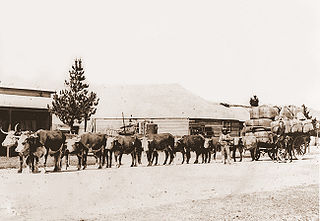
A working animal is an animal, usually domesticated, that is kept by humans and trained to perform tasks instead of being slaughtered to harvest animal products. Some are beasts of burden that provide transportation and aid in physical labor, while others are service animals trained to execute certain specialized tasks. They may also be used for milking or herding. Some, at the end of their working lives, may also be used for meat or other products such as leather.
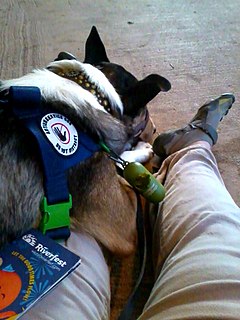
An autism assistance dog or autism service dog is an assistance dog trained to assist an autistic person to help them gain independence and the ability to perform activities of daily living similar to neurotypical individuals.

A cape, jacket, or vest is an article worn by a working dog to identify or assist them in their job.

Animal-assisted therapy is an alternative or complementary type of therapy that includes the use of animals in a treatment. It falls under the realm of Animal Assisted Intervention, which encompasses any intervention in the studio that includes an animal in a therapeutic context such as emotional support animals, service animals trained to assist with daily activities, and animal assisted activity. Animal-assisted therapy can be classified by the type of animal, the targeted population, and how the animal is incorporated into the therapeutic plan. The most commonly used types of animal-assisted therapy are canine-assisted therapy and equine-assisted therapy. The goal of animal-assisted therapy is to improve a patient's social, emotional, or cognitive functioning and literature reviews state that animals can be useful for educational and motivational effectiveness for participants. Studies have documented some positive effects of the therapy on subjective self-rating scales and on objective physiological measures such as blood pressure and hormone levels.
A psychiatric assistance dog or psychiatric service dog is a sub-category of assistance dog trained to assist their handler with a psychiatric disability or a mental disability, such as obsessive-compulsive disorder, post-traumatic stress disorder, schizophrenia, depression, anxiety, and bipolar disorder.

Orca was a male golden retriever trained by the UK charity Canine Partners as an assistance dog. As of 2007 he was one of 12 dogs to be awarded the PDSA Gold Medal, the highest award for outstanding bravery and dedication by an assistance dog, for remarkable dedication, tenacity and initiative in saving his owners' life in 2003, when he was still a young dog of 17 months age.
Canine Companions for Independence is a US-based 501(c)(3) nonprofit organization that trains and provides assistance dogs. As of 2018, it has placed over 6,000 assistance dogs with recipients at no charge.
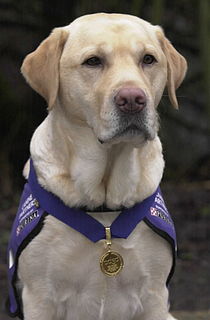
Endal was a male Labrador retriever in Britain whose abilities as a service dog and as an ambassador for service dog charitable work received worldwide news media coverage.
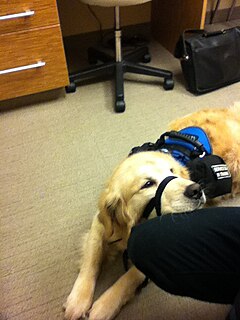
A medical response dog is a assistance dog trained to assist an individual who has a medical disability. Typically, they are dogs whose job does not handle primarily epilepsy or psychiatric-based conditions, though some seizure response dogs or psychiatric service dogs may also be referred to as medical response.
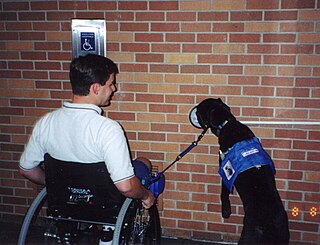
Dogs are the most common service animals, assisting people in many different ways since at least 1927. Other animals such as horses are allowed per the ADA in the U.S. The service animal is not required by the Americans with Disabilities Act to wear a vest, ID tag or a specific harness.
An emotional support animal (ESA) is an animal that provides relief to individuals with “psychiatric disability through companionship.” Under the Americans with Disabilities Act, an emotional support animal encompasses animals from all species.

A wheelchair is a chair with wheels, used when walking is difficult or impossible due to illness, injury, problems related to old age, or disability. These can include spinal cord injuries, cerebral palsy, brain injury, osteogenesis imperfecta, motor neurone disease, multiple sclerosis, muscular dystrophy, spina bifida, and more.

A diabetic alert dog is an assistance dog trained to detect high (hyperglycemia) or low (hypoglycemia) levels of blood sugar in humans with diabetes and alert their owners to dangerous changes in blood glucose levels. This allows their owners to take steps to return their blood sugar to normal, such as using glucose tablets, sugar and carbohydrate rich food. The dog can prompt a human to take insulin.

Pets for Vets is a 501(c)(3) non-profit organization in the United States dedicated to providing a second chance to shelter dogs by rescuing, training, and matching them with American veterans who need a companion pet. It was founded in 2009 to help veterans who were suffering from combat stress and other emotional issues. Each companion dog is rescued in connection with local animal rescue groups.
Freedom Service Dogs is a Denver, Colorado–based charitable organization devoted to rescuing dogs and training them as service dogs for people with disabilities that include multiple sclerosis, muscular dystrophy, Down syndrome, cerebral palsy, spinal-cord injury, PTSD, and more. The organisation is notable for its activities in providing assistance dogs to US veterans - one of the few such services that uses only rescued dogs.

















